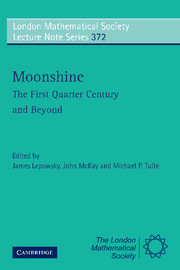 Moonshine - The First Quarter Century and Beyond
Moonshine - The First Quarter Century and Beyond Book contents
- Frontmatter
- Contents
- Preface
- Schedule of Talks
- Characters of Crossed Modules and Premodular Categories
- On the Injectivity of the Kudla-Millson Lift and Surjectivity of the Borcherds Lift
- Ordered Spanning Sets for Vertex Operator Algebras and their Modules
- Friendly Giant Meets Pointlike Instantons? On a New Conjecture by John McKay
- Modularity of Trace Functions in Orbifold Theory for ℤ-Graded Vertex Operator Superalgebras
- Twisted Modules for Vertex Operator Algebras
- Vertex Operators and Sporadic Groups
- The Algebraic Meaning of Being a Hauptmodul
- Borcherds' Proof of the Conway-Norton Conjecture
- On the Connection of Certain Lie Algebras with Vertex Algebras
- Vertex Operators and Arithmetic: How a Single Photon Illuminates Number Theory
- Rational Vertex Operator Algebras and their Orbifolds
- Quasi-finite Algebras Graded by Hamiltonian and Vertex Operator Algebras
- On Certain Automorphic Forms Associated to Rational Vertex Operator Algebras
- Moonshine and Group Cohomology
- Monstrous and Generalized Moonshine and Permutation Orbifolds
- New computations in the Monster
Vertex Operators and Sporadic Groups
Published online by Cambridge University Press: 06 July 2010
- Frontmatter
- Contents
- Preface
- Schedule of Talks
- Characters of Crossed Modules and Premodular Categories
- On the Injectivity of the Kudla-Millson Lift and Surjectivity of the Borcherds Lift
- Ordered Spanning Sets for Vertex Operator Algebras and their Modules
- Friendly Giant Meets Pointlike Instantons? On a New Conjecture by John McKay
- Modularity of Trace Functions in Orbifold Theory for ℤ-Graded Vertex Operator Superalgebras
- Twisted Modules for Vertex Operator Algebras
- Vertex Operators and Sporadic Groups
- The Algebraic Meaning of Being a Hauptmodul
- Borcherds' Proof of the Conway-Norton Conjecture
- On the Connection of Certain Lie Algebras with Vertex Algebras
- Vertex Operators and Arithmetic: How a Single Photon Illuminates Number Theory
- Rational Vertex Operator Algebras and their Orbifolds
- Quasi-finite Algebras Graded by Hamiltonian and Vertex Operator Algebras
- On Certain Automorphic Forms Associated to Rational Vertex Operator Algebras
- Moonshine and Group Cohomology
- Monstrous and Generalized Moonshine and Permutation Orbifolds
- New computations in the Monster
Summary
Abstract
In the 1980's, the work of Frenkel, Lepowsky and Meurman, along with that of Borcherds, culminated in the notion of vertex operator algebra, and an example whose full symmetry group is the largest sporadic simple group: the Monster. Thus it was shown that the vertex operators of mathematical physics play a role in finite group theory. In this article we describe an extension of this phenomenon by introducing the notion of enhanced vertex operator algebra, and constructing examples that realize other sporadic simple groups, including one that is not involved in the Monster.
Motivation
We begin not with the problem that motivates the article, but with motivation for the tools that will furnish the solution to this problem. The tools we have in mind are called vertex operator algebras (VOAs); here follows one way to motivate the notion.
In mathematics there are various kinds of finite dimensional algebras that have proven to be significant or interesting in some respect. For example,
(1) semisimple Lie algebras (with invariant bilinear form)
(2) simple Jordan algebras (of type A, B, or C)
(3) the Chevalley algebra (see [Che54])
(4) the Griess algebra (see [Gri82])
The items of this list are very different from each other in terms of their properties and structure theory. Perhaps the only thing they have in common (as algebras) is finite dimensionality.
Nonetheless, it turns out that there is such a process called affinization which associates a certain infinite dimensional algebra structure (let's say affine algebra), to each finite dimensional example in this list.
- Type
- Chapter
- Information
- Moonshine - The First Quarter Century and BeyondProceedings of a Workshop on the Moonshine Conjectures and Vertex Algebras, pp. 188 - 203Publisher: Cambridge University PressPrint publication year: 2010
- 1
- Cited by


